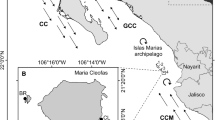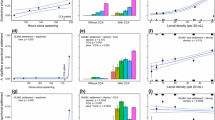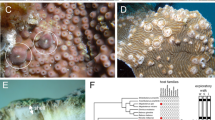Abstract
The burrowing bivalve Lithophaga curta is abundant (8 to 9 per 100 cm2) in the encrusting, hermatypic coral Montipora berryi at Enewetak; this is the first report of L. curta colonizing living coral. Conversely, larvae of M. berryi appear to settle in empty bivalve burrows, tentatively identified as those of L. curta, located in dead M. berryi. Several hypotheses are suggested on the adaptive significance of substrate selection by larvae of both species and an overall hypothesis of reciprocal recruitment, describing the dynamic aspects of this apparently co-evolved relationship, is proposed.
Similar content being viewed by others
Literature Cited
Al-Hussaini, A. H.: The feeding habits and the morphology of the alimentary tract of some teleosts living in the neighborhood of the Marine Biological Station, Ghardapa, Red Sea. Publs mar. biol. Stn Ghardaqa 5, 1–61 (1947)
Arnaud, P. M. and B. A. Thomassin: First records and adaptive significance of boring into a free-living scleractinian coral (Heteropsammia michelini). Veliger 18, 367–374 (1976)
Bak, R. P. M.: The growth of coral colonies and the importance of crustose coralline algae and burrowing sponges in relation with carbonate accumulation. Neth. J. Sea Res. 10, 285–337 (1976)
Barnes, D. J., R. W. Brauer and M. R. Jordan: Locomotory response of Acanthaster planci to various species of coral. Nature, Lond. 228, 343–344 (1970)
Bayne, B. L.: Growth and the delay of metamorphosis of the larvae of Mytilus edulis (L.). Ophelia 2, 1–47 (1965)
Connell, J. H.: Population ecology of reef-building corals. In: Biology and geology of coral reefs. Vol. 2. Biology, pp 205–245. Ed. by O. A. Jones and R. Endean. New York and London: Academic Press 1973
Crisp, D. J.: Factors influencing the settlement of marine invertebrate larvae. In: Chemoreception in marine organisms, pp 177–265. Ed. by P. T. Grant and A. N. Mackie. New York and London: Academic Press 1974
Crisp, D. J.: Settlement responses in marine organisms. In: Adaptation to environment: essays on the physiology of marine animals, pp 83–124. Ed. by R. C. Newell. London-Boston: Butterworths 1976
Fishelson, L.: Ecological and biological phenomena influencing coral-species composition on the reef tables at Eilat (Gulf of Aqaba, Red Sea). Mar. Biol. 19, 183–196 (1973)
Glynn, P. W., R. H. Stewart and J. E. McCosker: Pacific coral reefs of Panama: structure, distribution and predators. Geol. Rdsch. 61, 483–519, (1972)
Gohar, H. A. F. and G. N. Soliman: On three mytilid species boring in living corals. Publs mar. biol. Stn Ghardaqa 12, 66–98 (1963)
Goreau, T. F., N. I. Goreau, T. Soot-Ryen and C. M. Yonge: On a new commensal mytilid (Mollusca: Bivalvia) opening into the coelenteron of Fungia scutaria (Coelenterata). J. Zool., Lond. 158, 171–195 (1969)
Goreau, T. F., N. I. Goreau and C. M. Yonge: On the mode of boring in Fungiacava eilatensis (Bivalvia: Mytilidae). J. Zool., Lond. 166, 55–60 (1972)
Goreau, T. F., N. I. Goreau, C. M. Yonge and Y. Neumann: On feeding and nutrition in Fungiacava eilatensis (Bivalvia, Mytididae), a commensal living in fungiid corals. J. Zool., Lond. 160, 159–172 (1970)
Highsmith, R. C.: Corals: the inside story, 321, pp. Ph.D. dissertation, University of Washington, Seattle 1979
Iredale, T.: Mollusca, Part I. Scient. Rep. Gt Barrier Reef Exped. 5, 209–425 (1939)
Kleeman, K. H.: A new species of Lithophaga (Bivalvia) from the Great Barrier Reef, Australia. Veliger 20, 151–154 (1977)
Knight-Jones, E. W.: Decreased discrimination during settling after prolonged planktonic life in larvae of Spirorbis borealis (Serpulidae). J. mar. biol. Ass U.K. 32, 337–345 (1953)
MacGeachy, J. K. and C. W. Stearn: Boring by macro-organisms in the coral Montastrea annularis on Barbados reefs. Int. Revue ges. Hydrobiol. 61, 715–745 (1976)
Marshall, N., A. G. Durbin, R. Gerber and G. Telek: Observations on particulate and dissolved organic matter in coral reef areas. Int. Revue ges. Hydrobiol. 60, 335–345 (1975)
Neudecker, S.: Transplant experiments to test the effect of fish grazing on coral distribution. Proc. 3rd int. Symp. Coral Reef 2 317–323 (1977). (Ed. by D. L. Taylor. Miami: School of Marine and Atmospheric Sciences, University of Miami)
Ogden, J.: Carbonate-sediment production by parrot fish and sea urchins on Caribbean reefs. In: Reefs and related carbonates-ecology and sedimentology, pp 281–288. Ed. by S. H. Frost, M. P. Weiss and J. B. Saunders. Tulsa, Oklahoma: American Association of Petroleum Geologists 1977. (Stud. Geol. Am. Ass. Petrol. Geol. No. 4)
Otter, G. W.: Rock-destroying organisms in relation to coral reefs. Scient. Rep. Gt Barrier Reef Exped. 1, 323–352 (1937)
Potts, D. C.: Growth interactions among morphological variants of the coral Acropora palifera. In: Coelenterate ecology and behavior, pp 79–88. Ed. by G. O. Mackie. New York and London: Plenum Press 1976
Randall, J. E.: Food habits of reef fishes of the West Indies. Stud. trop. Oceanogr., Miami 5, 665–847 (1967)
Randall, J. E.: The effect of fishes on coral reefs. Proc. 2nd int. Symp. coral Reefs 2, 159–166 (1974). (Ed. by A. M. Cameron et al.. Brisbane; Great Barrier Reef Committee)
Randall, J. E. S. M. Head and A. P. L. Sanders: Food habits of the giant humphead wrasse, Cheilinus undulatus (Labridae). Envir. Biol. Fish. (The Hague, W. Junk) 3, 235–238 (1978)
Rosen, B. R.: Principal features of reef coral ecology in shallow water environments of Mahe, Seychelles. Symp. zool. Soc. Lond. 28, 163–183 (1971)
Roughgarden, J.: Evolution of marine symbiosis-a simple cost-benefit model. Ecology 56, 1201–1208 (1975)
Vaillant, L.: Recherches sur la faune malacologique de la baie de Suez. J. Conch., Paris 13, 97–127 (1865)
Vance, R. R.: A mutualistic interaction between a sessile marine clam and its epibionts. Ecology 59, 679–685 (1978)
Wells, J. W.: Recent corals of the Marshall Islands. Prof. Pop. U.S. geol. Surv. 260-I, 385–486 (1954)
Wells, J. W.: Scleractinia. In: Treatise on invertebrate paleontology, part F, pp 328–444. Ed. by R. Moore. Lawrence, Kansas: Geological Society of America and University of Kansas Press 1956
Wilson, D. P.: The settlement behaviour of the larvae of Sabellaria alveolata. J. mar. biol. Ass. U.K. 48, 387–435 (1968)
Author information
Authors and Affiliations
Additional information
Communicated by N. D. Holland, La Jolla
Rights and permissions
About this article
Cite this article
Highsmith, R.C. Burrowing by the bivalve mollusc Lithophaga curta in the living reef coral Montipora berryi and a hypothesis of reciprocal larval recruitment. Mar. Biol. 56, 155–162 (1980). https://doi.org/10.1007/BF00397132
Accepted:
Issue Date:
DOI: https://doi.org/10.1007/BF00397132




